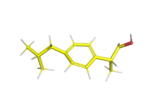This is the second post in a series aiming at generating a range of candidate structures for evaluation in the context of molecular modeling in the field of ion mobility spectrometry. In a previous post, the use of rdkit to generate structures was introduced. However, closer inspection of the code highlights a few funciton calls aimed at optimizing the conformer structures. Given that the tetraalkylammonium ions were the focus of that effort, the optimization step was quite rapid. This brought into question as to whether any geometry optimization was being performed. In the following jupyter notebook, ibuprofen generated from SMILES input is optimized using the same function call as found in the previous post. This degree of optimization does not reach the level needed for more advanced calculations but can be a decent start when trying to group the different conformers into structural families.
Required python modules include: rdkit
Optional modules: pymol and an instance of this program running as a server.

Comments are closed